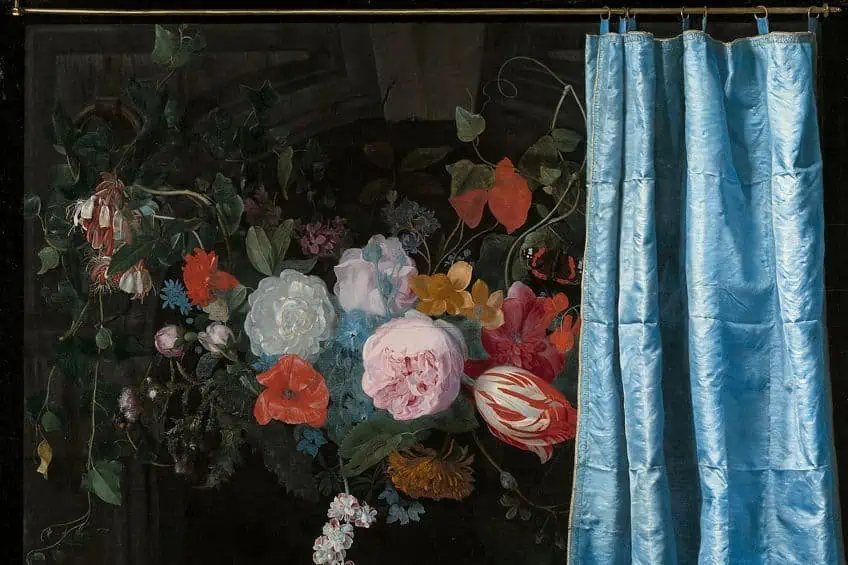Trompe l’oeil – The Art of Deceiving the Eye With Paint
What is trompe l’oeil art? What are the best examples of trompe l’oeil art? And who are some of the most popular trompe l’oeil artists? The art of trompe l’oeil has existed for centuries, with many artists attempting their hand at the art of the illusionistic painting technique. Translated in English to “deceive the eye”, the term speaks for itself and has been visually transformed and rendered in many famous paintings, which we will dive into below. In this article, we will explore the term trompe l’oeil and take a look at a few trompe l’oeil examples that will introduce you to some of the ways that artists in art history have explored the concept. Read on for more about this interesting French painting technique!
Contents
An Introduction to Trompe l’oeil Art
“Everything we see hides another thing…we always want to see what is hidden by what we see.” (René Magritte). What is trompe l’oeil art? You may have heard of the term trompe l’oeil in your local painting class or as a term that frequents the realm of visual analysis. The term is a French term that translates into English as “deceive the eye” and is one of the most attempted painting techniques in art history.

The trompe l’oeil painting technique involves recreating a three-dimensional image on a two-dimensional surface and is meant to present an illusion that tricks the viewer’s eye into believing that the perceived space is real. Most trompe l’oeil paintings have a strong connection with architecture through the element of forced perspective to add value to interior spaces and create interesting illusions from which one can either be inspired or transported into a different space.
A Brief History of Trompe l’oeil
The term “trompe l’oeil” also emerged in connection with the French draftsman and painter Louis-Léopold Boilly, who adopted the term as the title of an early 19th-century artwork that was exhibited at the Paris Salon. The term did, however, exist before its popularized use in the 19th century and was also used in the age of antiquities in ancient Greek and Roman murals. Traditional trompe ‘l’oeil murals portrayed images such as doorways, windows, or hallways, which alluded to the addition of another interior space or chamber for decorative purposes.
Trompe ‘loeil also finds itself in ancient narratives of antiquarian Greece in an old story of a contest between two Gods, Parrhasius and Zeuxis.
Zeuxis created a still-life painting of a bunch of grapes, which was so realistic that even the birds flew down to peck at them. Parrhasius was impressed but did not reveal his talents until he asked Zeuxis to critique one of his paintings. He directed Zeuxis to a painting behind some tattered-looking curtains but when Zeuxis tried to pull back the fabric, he was astonished to find that it was part of the painting itself. This trick of the eye technique was thus born out of the contest between Parrhasius and Zeuxis.

One cannot also mention trompe ‘l’oeil during the early Renaissance without mentioning the most celebrated painter of all time, Giotto, who tricked Cimabue by painting an image of a small fly onto his master’s painting. According to the account, Cimabue went crazy trying to get the fly to leave his beloved masterpiece alone. This was how realistic Giotto rendered the insect and speaks to the very essence of trompe ‘l’oeil painting as the original art of illusion.
The Influence of Perspective on Trompe l’oeil Painting
To construct the illusion of a three-dimensional space, one has to consider the role of perspective in creating illusions of space. Perspective drawing saw a sharp increase in the number of Renaissance artists interested in perspective techniques, which featured in many Renaissance paintings. Proto-Renaissance artists like Giotto also incorporated different perspective techniques toward the end of the 13th century, which can be seen in his fresco cycle of Assisi.
Other Italian Quattrocento painters such as Melozzo da Forli and Andrea Mantegna started their ventures into illusionistic ceiling paintings, which added an extra layer of dimension to many religious buildings.
Techniques such as foreshortening helped present the illusion of extra space in painting for viewers looking at paintings on the ceiling. The specific genre of trompe l’oeil painting on ceilings is known as di sotto in sù. Di sotto in sù translates in English to “from below, upwards” and was created using a true vanishing point perspective.
The Assumption of the Virgin (1526 – 1530) by Antonio Correggio
| Artist Name | Antonio Allegri da Correggio (1489 – 1534) |
| Date | 1526 – 1530 |
| Medium | Fresco |
| Dimensions (cm) | 1093 x 1195 |
| Where It Is Housed | Cathedral of Parma, Parma, Italy |
The Assumption of the Virgin by Antonio Correggio is among the most famous trompe l’oeil examples in art history, which adorns the Italian Cathedral of Parma. Correggio was commissioned for the artwork in 1522 and completed the large-scale trompe l’oeil painting in 1530. Correggio’s painting was one of the first impactful trompe l’oeil paintings in Italian art history that would later become a major source of inspiration for many di sotto in sù artists of the 17th century.
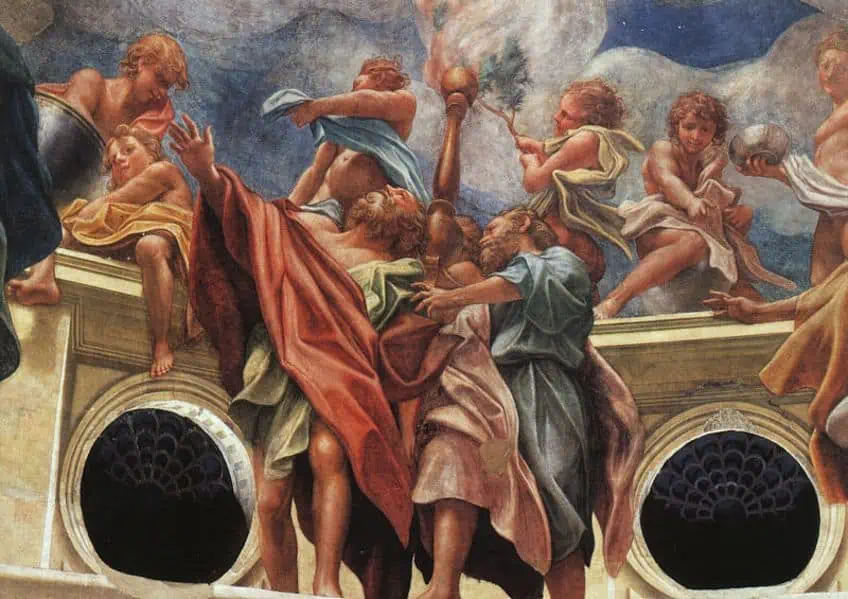
The painting’s composition was inspired by the perspective techniques of Melozzo da Forli, which presents the four guardian saints of Parma: Saint John the Baptist, Saint Hilary, Saint Thomas, and Saint Bernard. An admirable element of the painting is the impressive illusionistic manner in which Correggio presented the figures, which was for the time, astonishing to many viewers. Correggio’s work demonstrates his attention to foreshortening, which influenced many Baroque artists, later on, to incorporate the method into trompe l’oeil murals for vault décor.
Quadratura
The art of architectural illusion also opened up in the 17th century with the development of a technique called quadratura, which is a type of illusionistic ceiling painting that uses various trompe l’oeil methods and spatial techniques to create three-dimensional effects. Baroque and Mannerist churches of the 16th and 17th centuries often incorporated the quadratura technique in their dome ceilings to metaphorically open up the doors to heaven.
They did this by commissioning paintings with scenes that featured prominent biblical figures such as Jesus, Mary, the assumption, or the ascension.
Allegory of Divine Providence and Barberini Power (1633 – 1639) by Pietro da Cortona
| Artist Name | Pietro da Cortona (1596 – 1669) |
| Date | 1633 – 1639 |
| Medium | Fresco |
| Dimensions (cm) | Unavailable |
| Where It Is Housed | Palazzo Barberini, Rome, Italy |
Located in the Palazzo Barberini in Italy, this iconic trompe l’oeil painting was created by Pietro da Cortona in the 17th century. Cortona’s work on the fresco began in 1633 and was reworked extensively for many years until its finalization in 1639. The Palazzo was known as the long-standing home of the Barberini family, who were a popular noble Italian family during the 17th century. The large fresco features motifs from the Barberini family’s coat of arms such as bees and many suns. The stunning sky painting also features flying maidens as well as the crown of immortality and divine providence. The image of the crown of immortality refers to a religious metaphor, which takes the visual form of a ring of stars or laurel wreath and appears frequently in many Baroque-era allegorical paintings.
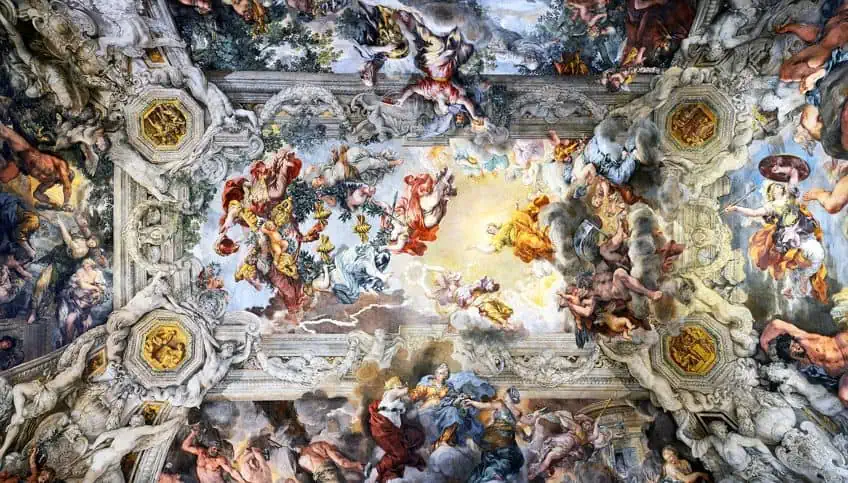
Italian architect and artist Baldassare Peruzzi championed the quadratura art style in painting, which highlights the height of forced perspective by leveraging the existing architectural framework to create stunning illusions of endless skies and divine beauty as expressed in early Christian art. The art of trompe l’oeil grew across Europe and was increasingly popular among Flemish and Dutch still-life artists of the 17th century. Dutch master Samuel Dirksz van Hoogstraten shared his theories on the art of trompe l’oeil painting and described the genre as an imitation of nature. In 1678, he published a text called Introduction to the Academy of Painting, or the Visible World, which further described his views on trompe l’oeil.
Quodlibet
Quodlibet is another form of trompe l’oeil painting that includes realistic depictions of ordinary objects and items such as playing cards, scissors, and paper knives portrayed as strewn around in a disorganized fashion. Other areas where trompe l’oeil was practiced included interior furniture such as tables and doors as seen in the Chatsworth house at Derbyshire.
These were executed by Jan van der Vaart.
Greenwich Painted Hall (1707 – 1726) by Sir James Thornhill
| Artist Name | Sir James Thornhill (1675 – 1734) |
| Date | 1707 – 1726 |
| Medium | Fresco |
| Dimensions (m2) | 3716 |
| Where It Is Housed | The Royal Naval College, London, United Kingdom |
Famous English painter Sir James Thornhill designed this magnificent hall painting between 1707 and 1726. This famous painted hall is one of the most grandiose trompe l’oeil paintings of the 18th century, spanning and massive 40,000 square feet. The mural is located in the Wren building and is also a classic example of the Baroque style of painting. The Painted Hall is one of the most celebrated Baroque interiors in Europe, which had undergone conservation in the mid-20th century, but due to time and exposure to elements such as the sun, fluctuations in its condition had already caused significant damage. Regardless, the hall still retains some of its spectacular visual qualities. Sir James Thornhill is also best known for his portrait of Sir Isaac Newton and the staircase mural at Hanbury Hall.
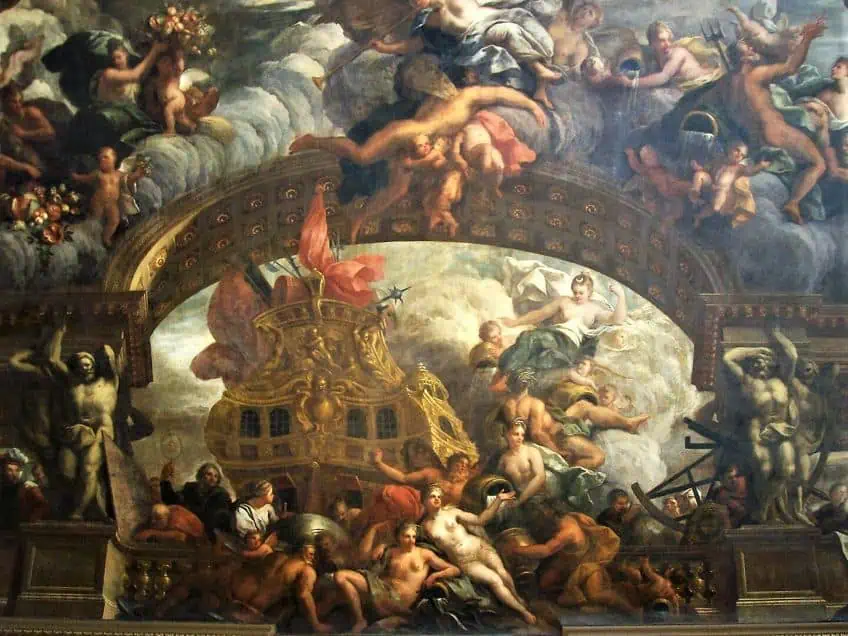
Trompe l’oeil and Cubism
The experimentation with trompe l’oeil painting techniques can also be seen in the Cubist movement. Similar to Cubism, which defies the representation of real-world objects through illusion and distortion. Trompe l’oeil painting techniques function similarly in that their illusionary effect carries a similar concept. Trompe l’oeil artists employed these illusionary effects in Cubist works to exploit the concept and invade the illusion of reality through the insertion of print media and mimicry of materials to disillusion the viewer and critique the materiality of reality.
Famous Cubist painters such as Georges Braque and Pablo Picasso also employed trompe l’oeil techniques to create alternative ways of distorting reality.
It is important to take note that the popularity and emphasis on trompe l’oeil painting declined in the 19th century so identifying connections to major movements like Cubism is vital to understanding the nature of deception in visual art. The introduction of collage art in the early 20th century also saw the emergence of newspaper clippings and wallpapers, which further thrust the perception of art and the psychology of bending reality in representation into the limelight. The similarities were contingent from the 17th century until the 20th century with many artists exploring the notions of falsehood, reality, originality, and truth. Below, we will explore some famous trompe l’oeil paintings that highlight the different concepts related to illusion and truth.
Still Life with Four Bunches of Grapes (1636) by Juan Fernández
| Artist Name | Juan Fernández (1629 – 1657) |
| Date | 1636 |
| Medium | Oil on canvas |
| Dimensions (cm) | 45 x 61 |
| Where It Is Housed | The Metropolitan Museum of Art, New York City, United States |
Among the appearance of curtains in the 17th century. Still-life artworks included popular motifs such as grapes and curtains, which can be considered early motifs for the practice of Illusionism. Juan Fernandez, better known as “El Labrador”, was a famous Spanish artist of his time whose works were compared to the myth of the God Zeuxis and specialized in painting bunches of grapes.

Still life with Four Bunches of Grapes is a famous painting by El Labrador, which presents an ideal rendering of four bunches of grapes to illustrate his eye for illusionism. Here, El Labrador highlights the dimensions of the grapes by setting the fruit against a high-contrast dark background.
He also added highlights to draw out the spherical shape of the grapes and created an illusion of roundness and three-dimensionality, which brought the painting to life.
Trompe l’Oeil Still Life with Flower Garland and Curtain (1658) by Adriaen van der Spelt and Frans van Mieris the Elder
| Artist Name | Adriaen van der Spelt (1630 – 1673) and Frans van Mieris the Elder (1635 – 1681) |
| Date | 1658 |
| Medium | Oil on panel |
| Dimensions (cm) | 46.5 x 63.9 |
| Where It Is Housed | The Metropolitan Museum of Art, New York City, United States |
Trompe l’Oeil Still Life with Flower Garland and Curtain is one of the most famous trompe l’oeil artworks of all time, created as a collaborative project between Adriaen van der Spelt and Frans van Mieris the Elder in the mid-17th century.
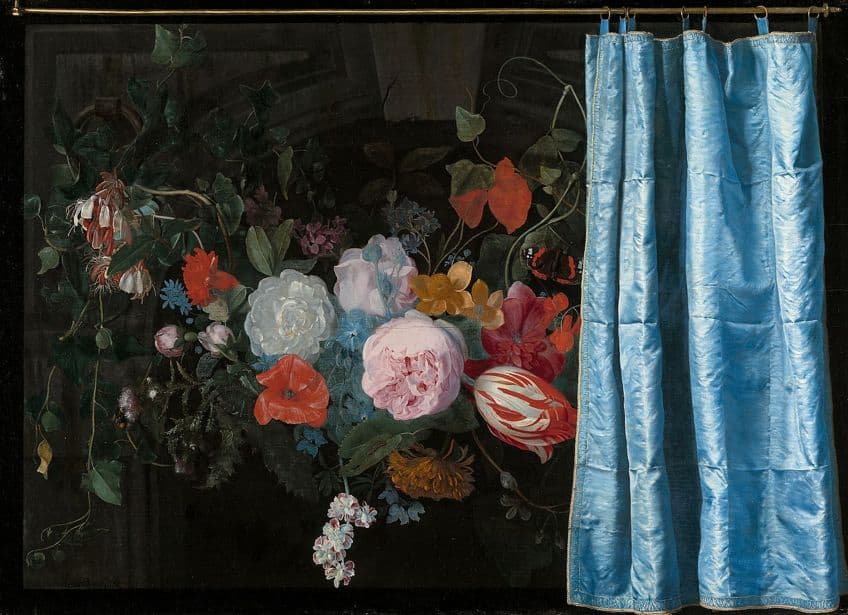
The painting illustrates a taffeta curtain draped on a rod across the top right side of the frame, executed by Van Mieris, which simultaneously obscures a bouquet painted by Van der Spelt. Many Dutch collectors of the 17th century shielded their paintings with curtains as a tool for raising the pictorial duplicity of the work. The painting also features other smaller false truths such as the camouflaged insects and the red admiral butterfly.
This creates an atmosphere of truths that appear to be “hidden in plain sight”.
The Human Condition (1933) by René Magritte
| Artist Name | René François Ghislain Magritte (1898 – 1967) |
| Date | 1933 |
| Medium | Oil on canvas |
| Dimensions (cm) | 100 x 81 |
| Where It Is Housed | The National Gallery of Art, Washington D.C., United States |
The Human Condition represents the height of Modern trompe l’oeil created by Belgian painter René Magritte in 1933. The painting is part of a series of four paintings under the same title that addresses the representation and perception of reality. Upon first glance, the painting resting on the easel appears to form part of the landscape scene in the background, blocked by the easel.
The twist or epiphany that the viewer is meant to arrive at involves the realization that the imagery of the painting is real and the painting on the easel is simply a representation of the real landscape. The two are thus read as a fabrication of the same source and the same reality created by Magritte. Magritte in turn highlights a part of the human condition whereby the observer encounters and is perhaps forced against their will to see the difference between the real and the representation.
Other famous Modern trompe l’oeil artists include John de Andrea, Richard Estes, Carole Feuerman, and Andy Warhol.
Quetzalcoatl, Ecatepec de Morelos (2016) by John Pugh
| Artist Name | John Pugh (1957 – Present) |
| Date | 2016 |
| Medium | Wall mural |
| Dimensions (cm) | Unavailable |
| Where It Is Housed | Ecatepec de Morelos, Mexico City, Mexico |
Examples of Contemporary painting can be seen in artworks by John Pugh such as Quetzalcoatl, which was commissioned by the government of Mexico in 2016. John Pugh uses trompe l’oeil painting in large-scale murals as a way to communicate with the public while creating spectacular and colorful three-dimensional spaces on public buildings. John Pugh is one of the most popular Contemporary trompe l’oeil painters to date, who has received more than 250 private and public commissions. Pugh focuses his intentions on creating public attractions that are not designed in a traditional mural manner. According to the artist, he regards his murals as “dynamic anomalies” that visitors can engage with. and comprehend as architectural events or public phenomena of the urban landscape.

The art of trompe l’oeil painting is much more diversified than one might assume, and can be employed to relay complex messages that deal with concepts of reality, truth, and border on notions of the sublime. We hope that this article has helped shape your understanding of the technique and its variations! Some famous Contemporary trompe l’oeil artists to look out for include Duane Hanson, Steve Wolfe, Liu Bolin, James White, Gavin Turk, and Edgar Müller.
Frequently Asked Questions
What Is Trompe-l’oeil Painting?
Trompe-l’œil painting refers to an artistic painting technique and concept that is associated with creating a highly realistic illusion of three-dimensional space, rendered on a two-dimensional surface. The purpose of the technique is to trick the viewer into believing that the painted surface is real and possesses depth.
What Are the Characteristics of Trompe-l’oeil Art?
The characteristics of trompe l’oeil art include paintings that make use of various perspective techniques and shading to make a two-dimensional surface appear three-dimensional.
Who Are the Most Famous Trompe l’oeil Artists?
The most famous trompe l’oeil artists include Andrea Mantegna, Masaccio, William Michael Harnett, Maurits Cornelis Escher, René Magritte, Richard Haas, Julian Beever, John Pugh, Pietro da Cortona, and Antonio Correggio.
Liam Davis is an experienced art historian with demonstrated experience in the industry. After graduating from the Academy of Art History with a bachelor’s degree, Liam worked for many years as a copywriter for various art magazines and online art galleries. He also worked as an art curator for an art gallery in Illinois before working now as editor-in-chief for artfilemagazine.com. Liam’s passion is, aside from sculptures from the Roman and Greek periods, cave paintings, and neolithic art.
Learn more about Liam Davis and about us.
Cite this Article
Liam, Davis, “Trompe l’oeil – The Art of Deceiving the Eye With Paint.” artfilemagazine – Your Online Art Source. August 28, 2023. URL: https://artfilemagazine.com/trompe-loeil/
Davis, L. (2023, 28 August). Trompe l’oeil – The Art of Deceiving the Eye With Paint. artfilemagazine – Your Online Art Source. https://artfilemagazine.com/trompe-loeil/
Davis, Liam. “Trompe l’oeil – The Art of Deceiving the Eye With Paint.” artfilemagazine – Your Online Art Source, August 28, 2023. https://artfilemagazine.com/trompe-loeil/.


